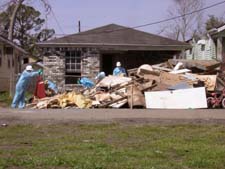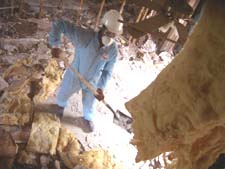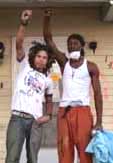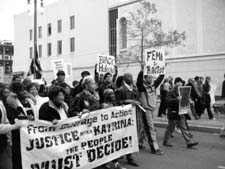Posted August 27, 2006
— Joanna Dubinsky
A letter to U.S. social justice activists.

It is no exaggeration to call the ongoing situation in New Orleans a war. When I drive around the city, I see mile after mile after mile of flooded houses—with hardly a sign of life—their brown flood lines still clearly visible, many with windows and doors ajar, some with mounds of gutted walls and furniture piled on the curb. These piles are taken away, only to be replaced by more debris. This happens over and over again.
And this is still happening, a year later.
You look around this city and you say: “Something horrific happened here.”
This is war.
What happened in New Orleans is politically important for the broader lessons it can teach us about race, class, gender, poverty, the environment, government “security,” the “push/pull” of immigration, and the crumbling infrastructure of the United States. All of these forces intersect under disaster capitalism and neoliberal restructuring. Racism is woven throughout each aspect of the disaster and aftermath.
I’ve spent the last year thinking about this—everyday— and I still have a hard time wrapping my brain around it.
It is important to apply these lessons to the “many Katrinas” we experience. In all of our cities there is poverty and racism, neoliberal restructuring, increased militarization and privatization, and gentrifying forces that continually displace poor people of color. There are also “natural disasters” waiting to happen—earthquakes, floods, fires, tornadoes, tsunamis and more hurricanes—all of which will be exacerbated by a crumbling infrastructure—a system that has declined across the United States precipitously since 2001.

Some fellow social justice activists around the country have told me that the Katrina moment has passed; we need to move on. This made me realize that we may be far off from understanding the political significance of this event in the way that African Americans have recognized the centrality of Katrina. There are particular things about the tragedy in New Orleans that will continue to make it an important struggle for years to come. I want to emphasize 10 critical points that I think can be lost in general discussions. I will then conclude with some suggestions and resources for moving forward in the fight for a just reconstruction of New Orleans and beyond.
1) The catastrophe that happened in New Orleans was entirely predictable.
Government simulations predicted many of the outcomes, right down to the number of people who would be left in the city due to lack of mobility: 100,000. In fact, the flooding of New Orleans was continuously ranked as one of the top three catastrophic domestic disasters about to happen.
This is because New Orleans is a city largely below sea-level. It is a bowl. Social geographer Pierce Lewis called New Orleans: “an inevitable city on an impossible site.” New Orleans continues to be “inevitable” and “impossible” as a port at the mouth of the Mississippi river. As of 2004, the port of South Louisiana saw the highest total trade by cargo volume in the country, and New Orleans ranked seventh largest in volume. Much of this is due to offshore oil extraction and production. One quarter of all oil consumed in the US is extracted off Louisiana’s coast.
2) The flooding of New Orleans could have been prevented by preserving coastal marshlands and an adequate levee system. The destruction was caused by the federal government’s lack of political will, not a natural disaster.
The coastal marshlands have been destroyed by the oil and shipping industries. The cries for restoration—from activists and politicians— have gone unheeded. Without these wetlands’ buffering qualities, the city is more vulnerable to hurricanes. Adequate levees are also essential. If the Army Corps of Engineers—the federal government—had built the levees to their own specifications the flood might not have happened. In some places where the levee was weak and subsequently breached, the Army Corps of Engineers had failed to anchor pilings into the ground—sometimes missing the proper depth by more than 10 feet. Contrast this with the state of the art levee system in the Netherlands. It is clear that Katrina is the result of one set of political priorities.
Many folks—as you will see in Spike Lee’s upcoming four-hour documentary “When the Levees Broke”—believe that the levees were bombed by the government. This is not without precedent—our government has bombed levees, always to the detriment of poor people. But I would argue that the failure to build adequate levees is gross negligence, no different than a direct bombing. This neglect continues, as Congress failed to commemorate the anniversary of Katrina before breaking for a month-long August recess. Although non-binding, the proposed resolution’s mere mention of “commitment” to the Gulf Coast had many politicians balking.
3) The flooding of New Orleans was the most expensive disaster in U.S. history.

Eighty percent of a major American US city was flooded. Such a damaging force could only be matched by massive bombing. The level of damage was so great reporters resorted to recalling scenes from past wars. The cost has far exceeded what the government would have paid for adequate protection in the first place. This is a reflection of our government priorities across the board—placing war and corporate profits above safety and security of US citizens.
4) The flooding caused massive death and suffering.
The death toll continues to rise; it now stands at well over 1,500, with hundreds still missing. Bodies have been found—often by relatives— nearly a year after the flood, often pinned beneath furniture in un-gutted homes.
5) In addition to these initial deaths, massive displacement continues to contribute to the deaths and suicides— at triple the national average rate— and continues to tear thousands of lives apart in a way that can only be compared to war—or slavery.
The population shift caused by the Katrina Diaspora is comparable only to the Great Migration of the early 20th Century, or the mass migration of the 1930s as a result of the dust bowl. There is no exact count, but perhaps as many as 250,000— or at least half of the pre-Katrina population of New Orleans proper— remain in the Diaspora. Perhaps fewer than 200,000 currently live in the city, but this includes many new residents. The comparison to war is apropos given the mental health crisis this dislocation and destruction has caused. Many African Americans compare the vast displacement and splitting up of families to slavery. One woman in Spike Lee’s film likened the experience of dealing with evacuation and FEMA to being “on the auction block.”
6) This forced Diaspora is disproportionately made up of poor Black people and households headed by single women. There could not be a clearer illustration of how institutional racism functions.
In our country—due to gross neglect of our government which led to the destruction of a city, poor Black folks were removed, some forcibly at gun point, after many days of suffering and witnessing family members die or be split up. This resulted in weeks and months of dislocation for some families. Many were taken to shelters where they were surrounded by armed guards—as if they were the criminals, instead of victims of government neglect.
Many of these folks were taken from the only city they had ever known: New Orleans had one of the largest native born populations in the US. Through conscious government policy, including various policies that encourage employing those who are not from the region, many people cannot return. Affordable housing is nonexistent— the majority of public housing has remained shuttered, while rents have doubled and tripled. This action and inaction create multiple barriers for return.
The Institute for Women’s Policy Research has found that women, especially African American women, have not been able to return to the city. Single mother families have decreased from 51,000 pre-Katrina to 17,000 post-Katrina. African American women were the most vulnerable pre-Katrina (they were most likely to earn poverty wages) and this vulnerability, combined with the need for healthcare, schools, and childcare make it incredibly difficult to return.
In addition, constant police and National Guard presence—a happy marriage of the prison and military industrial complex—have all but criminalized the return to the city of Black men, especially young Black men, through constant harassment and unjustified arrests. Those arrested are funneled into a broken criminal justice system with too few public defenders— 6,000 people are currently awaiting trial, many of whom have not seen their lawyer in months.
7) While Bush promised to address poverty and the legacy of racism, the biggest beneficiaries of government aid to the region have been corporations.
What of the promises Bush made in Jackson Square, when the city was still partially submerged? Bush promised “to do what it takes” to rebuild the region and people’s lives. In an historic moment for his administration, the President promised to confront poverty (and the legacy of racism that caused this poverty) with “bold action.”
There has been hardly any action, bold or otherwise, on this front. “Worker recovery accounts” and an “Urban Homestead Act” never materialized. Instead Bush’s first response was suspension of the prevailing wage law. Not surprisingly government policies—both through action and inaction—have actually contributed to poverty. Many survivors, especially in the diaspora, are still without jobs one year after the storm. A Works Progress Administration-style reconstruction, offering survivors jobs to rebuild their city – something vaguely mentioned by a few Democrats, then quickly dismissed after the frenzy of post-Katrina support for poor people subsided—would have been a way to combat poverty. Instead survivors find that they are often “locked out” of jobs, while immigrants, drawn to the region by employers both legally (through H2B Visa Programs) and under the table, are “locked in” to substandard working-conditions and pay. (For more on pitting workers of color against each other, see And Injustice for All: Workers Lives in the Reconstruction of New Orleans a report based on 700 worker interviewers)
Almost one year after the storm, not a single dollar of Federal Housing Repair or Home Reconstruction monies have made it into the hands of New Orleanians. All the money you’ve heard about has been directed to—not surprisingly— the disaster profiteers, many with direct connections to the Bush regime, who won their contracts through a no-bid process.
There continues to be very little to show for the millions spent in the Gulf Coast. “Blue roof” tarps, a temporary solution to destroyed roofs, cost as much as, or more than actually re-roofing a house. A FEMA trailer—a cramped, shoddily made travel trailer with, the Sierra Club warns, abnormally high levels of the carcinogen formaldehyde—costs over $60,000 for construction, placement, maintenance and removal. This amount could have bought a modest home in New Orleans pre-Katrina. Seventy thousand families still live in these trailers. Debris removal—which has cost the government $3.6 billion and is far from done— has proven particularly lucrative for the four companies that secured these no-bid contracts. They were paid four to five times more than it cost to have subcontractors perform the work.
8) Despite all the obstacles and the lack of government support or a real “plan” beyond “free market” reconstruction, folks continue to fight—even if not in mass coordinated struggle—to find their way home.
We, as fighters for social justice, should orient ourselves to this struggle, even if it has not fully articulated itself.
People want to play a role in the rebuilding of their city; they want self-determination. Fighters for social justice should support this struggle.

The United Nations Guiding Principles on Internal Displacement has much to say on what the conditions should be for the return of those who have been internally displaced (the term used instead of refugee, as they have not fled their country of origin: see the link to the US Human Rights Network. For New Orleans, this is particularly important because the culture and place of New Orleans is so important to its residents. Many have argued that New Orleans is the most African city in the United States. New Orleans culture—the food, the music, the way of life— is unique. I’ve traveled on four continents and never seen anything like it. New Orleans is especially unique because it has a culture that defies homogenization.
I think this defiance is well represented by the Mardi Gras Indian Culture—a tradition that honors American indigenous cultures as well as African cultures. In what other city do hundreds of working-class men—welders, roofers, plasterers— spend hundreds of hours sewing beaded suits, costing –in some cases— more than a quarter of their salary?
9) This struggle is continuing to manifest and define itself in the face of overwhelming onslaught on every front.
Despite the urgency of the struggle, we need to recognize that it will need to go on for years, not months.

The grassroots struggles in New Orleans— for public housing, affordable housing, “neighborhood viability,” for inclusive redevelopment plans, public services such as levees, schools, water, hospitals and healthcare, workers rights and employment— intersect with immigrant rights, environmental justice, police reform and anti-militarization of the city. These struggles are just now beginning to coalesce. Part of the problem is the lack of preexisting infrastructure and barriers caused by displacement and complete mental anguish inflicted on survivors. I’m talking Post Traumatic Stress Disorder. I’m talking the biggest mental health crisis we’ve ever seen in this country. The suicide rate in New Orleans is now triple the national average.
And the scale of the disaster is overwhelming. The flooding of New Orleans led not only to a complete evacuation, but to the near complete destruction of the city’s infrastructure. This destruction has been met with cutting edge neoliberal restructuring— massive privatization while services continue to deteriorate.
We’ve gone from 115 to 4 public schools, with the rest turned into charter schools and massively defunded. We have lost our public hospital so that that money could be redirected into private hospitals, with very limited indigent services. This is happening while the uninsured rate is on the rise and doctors say repeatedly that people will die due to lack of services. Public workers have been laid off, as the city grows over with weeds, traffic lights often don’t work, and other public services are left to further deteriorate. Unions—in the public and private sector— are under attack.
Outside of the city, survivors are struggling to organize councils where they can address their needs. Solidarity committees—those who support survivors— are also struggling to figure out their direction.
10) It is strategic and necessary—given the various intersections of social injustice and the complete abandonment by the government— to orient our social justice work to the struggle in New Orleans.
This requires us to think politically about this work, and not simply look at it as a relief effort. Volunteerism is necessary, but it is not the solution.

What happened in New Orleans was extremely important to African Americans across class lines, as Black folks across the country collectively said: these are our people and this is the manifestation of this racist system—we need to collectively fight. Although this collective consciousness—which included broad connections to the war—“every bomb dropped on Iraq explodes in New Orleans”—has not translated itself into a mass movement, I think important shifts have occurred and opportunities have been opened. What we learn in this struggle will be an important lesson for building an ongoing movement for justice.
Our challenge now, as fighters for social justice, is to make the abstract concrete. I recognize that this is not an easy task. Below are some suggestions that fall into roughly four categories: support organizing survivors where you are, support grassroots efforts on the ground, connect the struggle in New Orleans to other social movements, and educate people where you are. These are just a few ideas—be creative!!
What you and/or your group (community group, union, church etc.) can do:
- Demand government accountability for the failure of the levees and a fulfillment of its promises to the Gulf Coast—especially in addressing poverty in the region. Demand a just reconstruction, including a real Right of Return. Contact your political representatives. Organize protests and vigils. Educate your community.
- Connect with a Solidarity Committee in your city, where they exist, to support the organizing of survivor’s councils. (for more info, contact Kali Akuno of People’s Hurricane Relief Fund, kaliakuno@gmail.com)
- Sponsor a speaker from one of the community groups listed below to talk about the ongoing struggle on the ground and how you can help. This could include longer day or two day teach-ins. Reach out to other African American-led organizations in your area to co-sponsor these events.
- Fundraise for grassroots groups (you can make any event a fundraiser). Send resources. (many groups have “wish lists” on their websites).
- Check www.katrinaaction.org frequently to do quick, mostly online, actions.
- Build the demand for a just reconstruction in New Orleans and the Gulf Coast into the anti-war movement (and Palestinian self-determination and Right of Return movement). This needs to include but also go beyond slogans like “Make Levees Not War.” This could include teach-ins about political priorities that support war, but not building infrastructure to protect people and cities.
- Support a strong workers’ rights and immigrant rights “Black/Brown alliance” within a
just reconstruction/ redevelopment paradigm. (The Latino population grew from 3% to over 20% post-Katrina, causing strains between new workers and returning survivors). Groups interested in supporting this work, should contact the New Orleans Worker Justice Coalition (see below). - Screen When the Levees Broke by Spike Lee and hold a discussion.
- Volunteer in the region. Do your homework ahead of time; research groups, learn about New Orleans history. If you are white (and especially if you haven’t worked with people of color-led organizations) prepare yourself with an anti-racism training (People’s Institute is a good resource for this). Come humbled and ready to support local leadership and learn. Realize housing resources are limited; arrange housing ahead of time and be prepared for basic accommodations.
- Encourage and support youth to volunteer in the region. There is great potential to politicize youth around self- determination and fight against racism. This is something important we have witnessed, as young Black and white folks come to New Orleans to volunteer and then return to their cities transformed.
Community Groups in New Orleans
New Orleans Worker Justice Coalition
Fighting for workers rights and racial justice, especially Black/Brown unity.Advocates for Environmental Human Rights (AEHR)
Long-term fighters against environmental racism and advocates for a just Right of Return.
Contact Monique Harden, mharden-aehr@cox.netAdvocates for Louisiana Public Healthcare
Fighting for the reopening of the public hospital in New Orleans.
Common Ground
Volunteer organization offering mutual aid and support.People’s Hurricane Relief Fund
Building a United Front for self-determination of African Americans and all New Orleanians in a just reconstruction of New Orleans.People’s Institute for Survival and Beyond
Long-term anti-racism education and organizing group; provides educational workshops across the country.Families and Friends of Louisiana’s Incarcerated Children
Membership-based organization dedicated to creating a better life for all of Louisiana’s youth, especially those in the juvenile justice system.Katrina Action/Katrina Information Network
Constant updates on ways to support the fight for social justice in New Orleans. Includes profiles of experts.New Orleans Network
General information for social justice activists in New Orleans.Green Party of Louisiana
Critical Resistance
National abolition group (with Chapter in New Orleans), building a campaign for amnesty for all arrested during Katrina.Safe Streets, Strong Communities Coalition
Mission is to transform the New Orleans Criminal Justice System into one that creates safe streets and strong communities for everyone, regardless of race or economic status.
Contact Norris Henderson, nhenderson@jjpl.orgSurvivor’s Village
Fighting for the reopening of public housing and affordable housing in New Orleans.INCITE! Women of Color Against Violence
Building a women’s health clinic and organizing center in New Orleans. Contact Shana Griffin ambakeysha@yahoo.comSolidarity, New Orleans Branch
A socialist, feminist, anti-racist organization.
email nolasolid@yahoo.com
U.S. Human Rights Network
Atlanta-based organization which initiated a national campaign that calls on the US government to recognize Katrina survivors as Internally Displaced Persons (IDP) and to respect and adhere to the Guiding Principles on Internal Displacement.Must See Film
When the Levees Broke by Spike Lee.
The story of the struggle in New Orleans in the words of the people who experienced it. Illustrates the failures of the federal government. Released August 2006 by HBO.
